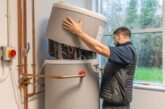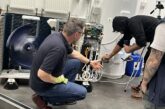
With Net Zero carbon targets firmly on the agenda, John Morris Renewables Business Development Manager at Grant UK, gives Professional Builder readers an opportunity to brush up on their heat pump knowledge.
Myth 1: Consumer demand for heat pumps is low
Consumers are becoming increasingly aware of their impact on the environment and are actively looking at ways in which they can reduce their carbon footprint. The Government’s Clean Growth Strategy is going to shape legislation that will move the market away from fossil fuels, making homeowners transition from high carbon heating systems to greener, more sustainable alternatives. Understanding and education on low carbon heating technologies is more widespread as well so, overall, the awareness of heat pumps amongst the consumer market is increasing.
Myth 2: Heat pumps are only suitable for new builds
Air source heat pumps are an ideal solution for new builds because the necessary energy-efficient measures can be installed during the early phases of a property’s build. However, that is not to say that an air source heat pump is solely suited to new homes. The Aerona³ heat pump, for example, has been installed into many existing homes, being retrospectively fitted to replace an older heating system. A retrofit installation may involve the installation of additional roof or wall insulation or other measures to reduce heat loss from the property, but provided the entire system has been properly designed, with correctly sized heat emitters and the most suitable heat pump output, an older home can comfortably go green with an air source heat pump.
Myth 3: Heat pumps do not work efficiently in the winter months
Heat pumps are designed to operate in low temperatures – Grant’s Aerona³ heat pump can operate in conditions as low as -20ºC – and while their SCOPs will not be as efficient when compared to operation in warmer outdoor temperatures, they still operate with good efficiencies. A heat pump will work considerably more in the winter months compared to the spring and summer but this should not be mistaken for inefficiency. Between November and February when a home’s heating and hot water demand is at its highest, a heat pump will use an estimated 63 per cent of its annual energy usage so during these months, electricity usage can be expected to increase. However, this usage will significantly drop during the remaining months of the year when the heat pump’s energy consumption is very low.
Myth 4: Heat pump product training is not essential
It is incredibly important for installers who are not currently installing heat pumps to complete training on this technology before they start working with them. Without suitable product training to give installers a solid understanding of how heat pumps work and what maximises their performance, there is a risk of installations being completed incorrectly which can result in underperforming heat pumps and therefore unsatisfied end-users. Air source heat pumps are different to install compared to a conventional boiler – a heat pump installation will not be a ‘like for like’ replacement installation and, as previously mentioned, thorough design preparation is needed.
More and more builders are now completing heat pump training and adding this renewable technology to their business offering, strengthening their expertise and broadening their customer base. Heat pump training from Grant UK is provided via practical courses at one of our Training Academies or online via the eLearning Academy and Professional Builder readers can choose the type of training that best suits their required level of knowledge.
For more details on Grant UK’s heat pump training visit www.grantuk.com/professional/training







